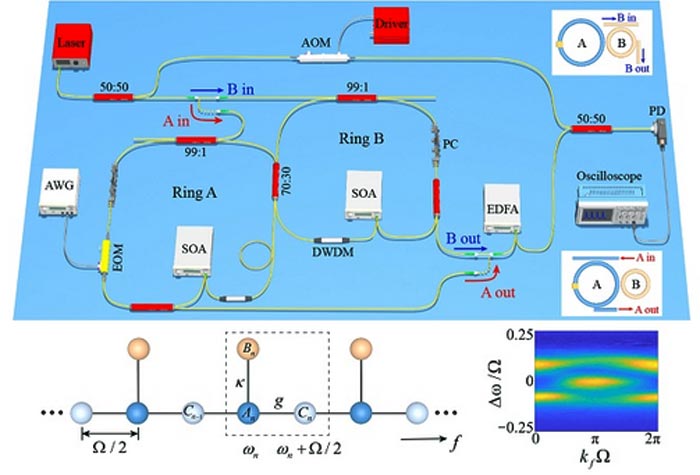Dynamic ring resonator offers new opportunity in synthetic frequency dimension

Synthetic stub lattice along the frequency axis of light in two coupled fiber rings of different lengths.
Credit: Guangzhen Li, Shanghai Jiao Tong University
A synthetic stub lattice in ring resonators represents a significant step toward construction of more complicated lattices in multiple rings associated with synthetic frequency dimensions.
Synthetic dimensions in photonics offer exciting new ways to manipulate light, to study physical phenomena with exotic connectivities, and explore higher-dimensional physics. Dynamically modulated ring resonator systems, where resonant modes are coupled to construct a synthetic frequency dimension, can provide great experimental flexibility and reconfigurability.
Construction of complex synthetic lattices, such as Lieb lattices and honeycomb lattices in multiple rings, will lead to rich opportunities for exploring exotic physical phenomena that currently exist only in the theoretical realm, such as parity-time phase transition in non-Hermitian systems and higher-order topologies. Toward experimental construction of more complicated multiring lattices, creating synthetic frequency space systems in two rings of different lengths is an important step.
As reported in Advanced Photonics, a team of researchers from Shanghai Jiao Tong University recently constructed a synthetic stub lattice along the frequency dimension. They used two coupled rings of different lengths, while the larger ring underwent dynamic modulation. Their study, which was the first such experimental demonstration, observed and verified the intrinsic physical properties of such lattices, especially the natural existence of the flat (dispersionless) band. They also observed the mode localization near the flat band. Such flat bands in the synthetic space can further be modified by introducing long-range couplings in the modulation, which enables transitions from flat to non-flat bands, for dynamic control of light.
In addition, by selectively choosing the input and output ports for excitations and transmission measurements, they were able to observe distinct band structure patterns. Such results differ remarkably from previous works on flat-band physics. They reveal that signals in the system can carry optical information from superposition modes in synthetic frequency dimensions.
This demonstration of exotic light manipulation may enable essential applications of optical communications in fiber-based or on-chip resonators. The work is also potentially a significant milestone: Construction of the stub lattice in two coupled rings of different lengths proves the experimental feasibility of connecting multiple rings of different types to construct complex lattices beyond line or square geometry in the synthetic space. The authors anticipate that their results may pave the way for future experimental realization of previous theoretical proposals.
Read the Gold Open Access article by G. Li, L. Wang, et al., “Observation of flat-band and band transition in the synthetic space,” Adv. Photon. 4(3) 036002 (2022), doi 10.1117/1.AP.4.3.036002.
Journal: Advanced Photonics
DOI: 10.1117/1.AP.4.3.036002
Article Title: Observation of flat-band and band transition in the synthetic space
Article Publication Date: 21-Jun-2022
Media Contact
Daneet Steffens
SPIE–International Society for Optics and Photonics
daneets@spie.org
Office: 360-685-5478
All latest news from the category: Physics and Astronomy
This area deals with the fundamental laws and building blocks of nature and how they interact, the properties and the behavior of matter, and research into space and time and their structures.
innovations-report provides in-depth reports and articles on subjects such as astrophysics, laser technologies, nuclear, quantum, particle and solid-state physics, nanotechnologies, planetary research and findings (Mars, Venus) and developments related to the Hubble Telescope.
Newest articles

Pinpointing hydrogen isotopes in titanium hydride nanofilms
Although it is the smallest and lightest atom, hydrogen can have a big impact by infiltrating other materials and affecting their properties, such as superconductivity and metal-insulator-transitions. Now, researchers from…

A new way of entangling light and sound
For a wide variety of emerging quantum technologies, such as secure quantum communications and quantum computing, quantum entanglement is a prerequisite. Scientists at the Max-Planck-Institute for the Science of Light…

Telescope for NASA’s Roman Mission complete, delivered to Goddard
NASA’s Nancy Grace Roman Space Telescope is one giant step closer to unlocking the mysteries of the universe. The mission has now received its final major delivery: the Optical Telescope…



